
The Amerton Railway is a 2 ft narrow gauge heritage railway in the English county of Staffordshire. It is owned by Staffordshire Narrow Gauge Railway Limited, a registered charity, and operated by volunteers.

There were more than a thousand British narrow-gauge railways ranging from large, historically significant common carriers to small, short-lived industrial railways. Many notable events in British railway history happened on narrow-gauge railways including the first use of steam locomotives, the first public railway and the first preserved railway.

Princes Risborough station is a railway station on the Chiltern Main Line that serves the town of Princes Risborough in Buckinghamshire, England. It is operated by Chiltern Railways.
British industrial narrow-gauge railways are narrow-gauge railways in the United Kingdom and the Isle of Man that were primarily built to serve one or more industries. Some offered passenger services for employees or workmen, but they did not run public passenger trains. They are categorized by the primary industry they served.

Decauville was a manufacturing company which was founded by Paul Decauville (1846–1922), a French pioneer in industrial railways. Decauville's major innovation was the use of ready-made sections of light, narrow gauge track fastened to steel sleepers; this track was portable and could be disassembled and transported very easily.
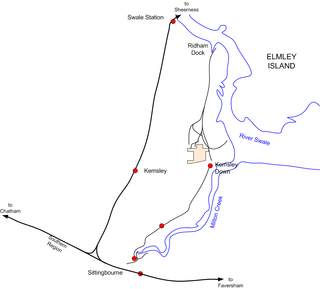
The Bowaters Paper Railway was a 2 ft 6 in narrow gauge industrial railway running from Sittingbourne to Ridham Dock on The Swale in the county of Kent. It had the distinction of being the last steam-operated industrial narrow gauge railway in Britain when it closed in 1969. Part of the system still operates as the Sittingbourne & Kemsley Light Railway.
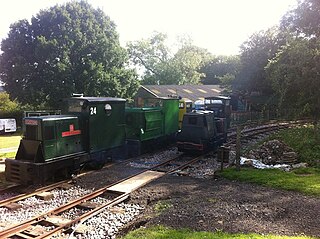
The Great Bush Railway is a private, 2 ft narrow gauge running round the edge of Tinkers Park, Hadlow Down, Sussex. The railway is operated by the Claude Jessett Trust Company. The line is 500 meters long and has three stations, Hadlow Down, Bracherlands Junction and Tinkers Lane.
The Creekmoor Light Railway was a small, privately run, 2 ft narrow gauge railway. It was situated off Creekmoor Lane, to the north of Poole, between Broadstone and Fleetsbridge, Dorset, and was operated by a group of local enthusiasts from October 1968, to April 1973.

Wantage Road railway station was a railway station on the Great Western Main Line in the Vale of White Horse district in Oxfordshire. The station was actually at the village of Grove, Oxfordshire, more than two miles north of Wantage. The station closed in December 1964 as part of the Beeching cuts.
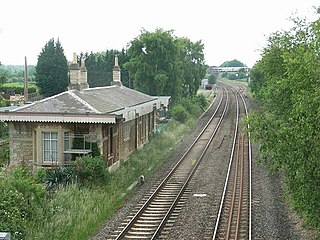
Aynho for Deddington railway station was a railway station serving the village of Aynho in Northamptonshire, England. It was on what is now known as the Cherwell Valley Line.
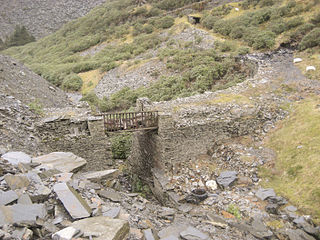
Some industrial narrow-gauge railways in the United Kingdom and the Isle of Man were primarily built to serve quarrying, mining, and similar industries. Some of these narrow-gauge railways offered passenger services for employees or workmen, but they did not run public passenger trains. They are listed by the primary industry they served.
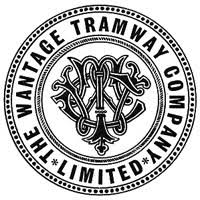
The Wantage Tramway Company was a two-mile tramway that carried passengers and freight between the Oxfordshire town of Wantage and Wantage Road Station on the Great Western Main Line in England. Formed in 1873 to link Wantage Road station with its terminus at Mill Street, Wantage the line was cheaply built parallel to what was then the Besselsleigh Turnpike, and now the A338. The tramway closed to passengers in 1925 and to goods traffic in 1945.
Wantage railway station is a closed stone and brick built station located on Mill Street, Wantage in Oxfordshire on the Wantage Tramway line. The station closed fully in 1945 when Wantage Tramway ceased operations.
Abingdon Road Halt railway station was built by the Great Western Railway to serve South Hinksey, a village near Oxford.
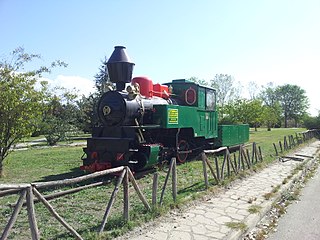
A number of private industrial railway lines were constructed in Greece for exclusive use by major mining operations and by extensive industrial facilities. There were also a few temporary lines, used for the construction of major public works. Most of them were either metre gauge or 600 mm narrow gauge.
Joseph Charles Victor Mitchell was a dentist, inventor, and pioneer railway preservationist. He was the author or editor of, and publisher of, more than 600 books on railways in the United Kingdom and Europe.

























